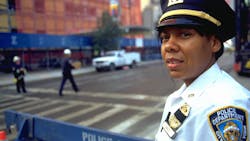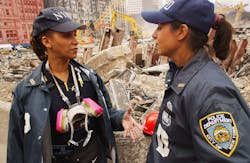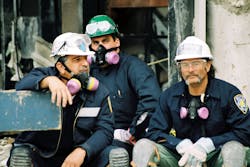How 9/11 Impacted Patrol Protocols
In this issue you can find an article regarding the patrol response to the Pentagon on the morning of September 11, 2001. The article discusses the performance of the Arlington County Police Department, the Arlington County Sheriffs Office and the Virginia State Police. As they responded, they had to coordinate activities with the Defense Protective Services personnel on duty at the Pentagon. While no one can (or should be) critical of how those agencies responded and performed, it’s always a good practice to perform the After Action Reviews. The goal is to find out, no matter how well we did, if there was anything we could have done better. What lessons could we learn?
In this article, we’re going to discuss how the lessons learned that day may have impacted patrol protocols on a day-to-day basis. Twenty years later it’s hard to recognize that we’re doing anything different—but is that compared to last year or 20-plus years ago? The reality of patrol response is this: it’s always evolving. Much to the public’s disbelief, law enforcement agencies are constantly changing how we perform our duties. We have no choice. Mandates from court decisions, insurance policies, new tool evolution and more all affect how we do our job. That said, we do our job each day with certain assumptions in place—and that’s probably the biggest lesson we learned on September 11, 2001: assume nothing. If you must make an assumption, always assume the worst.
After the attacks of September 11, 2001, public service agencies across the country realized how much they weren’t actively involved in the National Incident Management System. For decades prior to the terrorist attacks on our nation that morning, the NIMS system was largely the purview of the fire services. It was a tool used to coordinate response from multiple fire houses or agencies. The attack on our nation made it abundantly clear how all public safety agencies needed to be on the same page and operating from the same playbook. This is not a patrol response lesson, but a command lesson. That said, any command level change of protocol will inevitably (and this is a good thing) filter down to impact how every member of an agency does the job.
What this means is that command staff officers are better trained and more involved in NIMs protocols. The end result is that response to emergency events follows a more structured course of actions to more efficiently coordinate response from a wider variety of agencies and public service disciplines. Said differently, everyone works better together in a more timely fashion.General outlook is the second biggest change that was impacted. Prior to the attacks, if a patrol officer found a tanker (from a tanker truck) disconnected and sitting roadside, he may or may not see a potential threat. The totality of circumstances would determine such, but more often than not, it was assumed that something had broken down and someone would return for that tanker before long. A note would be made to check on it. Then the officer would resume patrol. After the terror attacks, if that tanker was found on the side of the road, the immediate perception of a potential threat existed. The potential for that tanker to be part of an attack or other emergency scenario was at the forefront of the patrol officer’s mind—and he responded accordingly. Why is this tanker here? What does it hold? Who owns it? What threat does it potentially present? What potential targets are nearby?
As a general rule, patrol officers pay attention to how people behave. We’re taught from the very beginning of our career that a person’s body language can give us indicators of a pending assault or of evasion on the part of the person we’re encountering. After the terror attacks of September 11, 2001, officers became almost hyper-aware of the behavior of others. Suspicious behavior was no longer simply some petty criminal trying to evade involvement with law enforcement. All of a sudden every petty criminal could be part of a terrorist cell and such evasions became even more suspicious.
Early on after the attacks, anyone found acting suspiciously or in an area they didn’t necessarily have business to be in (like under that bridge or behind that government building in an alleyway) were handled more carefully. Gone (at least temporarily) were the days of assuming someone was just somewhere they shouldn’t be by accident or for some low-concern reason. Even the obviously drunk guy staggering around had to be checked out. After all, weren’t we all told that the terrorists had info-gathering personnel too?Now here we are 20 years later and perhaps the only remaining noticeable impact on patrol protocols is the equipment we carry. With the advent of Active Shooter response just a year or two before the terror attacks, a greater emphasis on carrying trauma treatment basics was already in place. It has remained. Some agencies added protective (gas) masks to their patrol vehicles, issuing one to each officer where they could. A lot of agencies added in nitrile gloves and rubber boots, both in anticipation of a bio-chemical attack. Much of that has gone by the wayside or has long since been reduced in value/care.
Beyond that, can you think of any patrol protocols that you consider different today than they were prior to the terror attacks of September 11, 2001? A great many of our readers weren’t even working in the law enforcement profession then. With the average career lasting 20 to 25 years, a great many of you reading this weren’t even out of school yet when the attacks occurred so you’d be unaware of protocol evolution. So, take this challenge:
From what you know of the attacks, and being familiar with how you do your job today, can you think of anything that could be done different to offer greater protection from terror attacks? Please pass along any ideas you have: [email protected]. With that challenge issued, we encourage you to inventory your kit. Make sure it’s properly maintained. Pray you don’t need it, but make sure it’s ready to serve you if you do. Stay alert and let’s all do our part to make sure another such attack doesn’t occur. God help us, if it does, we’re all ready to respond as well as our brothers and sisters did that faithful morning.
About the Author
Lt. Frank Borelli (ret), Editorial Director
Editorial Director
Lt. Frank Borelli is the Editorial Director for the Officer Media Group. Frank brings 20+ years of writing and editing experience in addition to 40 years of law enforcement operations, administration and training experience to the team.
Frank has had numerous books published which are available on Amazon.com, BarnesAndNoble.com, and other major retail outlets.
If you have any comments or questions, you can contact him via email at [email protected].



